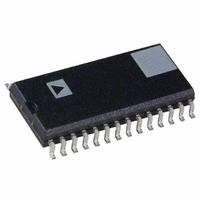AD73360AR-REEL7 Analog Devices Inc, AD73360AR-REEL7 Datasheet - Page 32

AD73360AR-REEL7
Manufacturer Part Number
AD73360AR-REEL7
Description
IC ANALOG FRONT END 6CH 28-SOIC
Manufacturer
Analog Devices Inc
Specifications of AD73360AR-REEL7
Number Of Channels
6
Rohs Status
RoHS non-compliant
Number Of Bits
16
Power (watts)
80mW
Voltage - Supply, Analog
3V
Voltage - Supply, Digital
3V
Package / Case
28-SOIC (7.5mm Width)
Analog Front End Type
General Purpose
Analog Front End Category
General Purpose
Interface Type
Serial (6-Wire)
Sample Rate
64KSPS
Input Voltage Range
1.64375V
Operating Supply Voltage (min)
4.5V
Operating Supply Voltage (typ)
5V
Operating Supply Voltage (max)
5.5V
Resolution
16b
Number Of Adc's
6
Power Supply Type
Analog/Digital
Operating Temp Range
-40C to 85C
Operating Temperature Classification
Industrial
Mounting
Surface Mount
Pin Count
28
Package Type
SOIC W
For Use With
EVAL-AD73360LEB - BOARD EVAL FOR AD73360L
Lead Free Status / RoHS Status
Not Compliant
AD73360
Configuring a Cascade of Two AD73360s to Operate in Mixed
Mode
This section describes a typical sequence of control words that
would be sent to a cascade of two AD73360s to configure them
for operation in Mixed Mode. It is not intended to be a defini-
tive initialization sequence, but will show users the typical input/
output events that occur in the programming and operation
phases
In Step 1, we have the first output sample event following device
reset. The SDOFS signal is raised on both devices simulta-
neously, which prepares the DSP Rx register to accept the ADC
word from Device 2 while SDOFS from Device 1 becomes an
SDIFS to Device 2. The cascade is configured as nonFSLB,
which means that the DSP has control over what is transmitted
to the cascade. The DSP will receive an invalid ADC word from
Device 2 and simultaneously Device 2 is receiving an invalid
ADC word from Device 1. As both AD73360s are in Program
Mode there is only one output event per sample period. The
DSP can now send a control word to the AD73360s.
In Step 2, the DSP has finished transmitting the control word to
Device 1. Device 1 recognizes that this word is not intended for
it so it will decrement the address field and generate and SDOFS
and proceed to transmit the control word to the next device in
the chain. At this point the DSP should transmit a control word
for Device 1. This will ensure that both devices receive, and act
upon, the control words at the same time.
Step 3 shows completion of the first series of control word writes.
The DSP has now received an ADC word from Device 2 and
each device has received a control word that addresses Control
Register B and sets the SCLK and Sample Rate. When pro-
gramming a cascade of AD73360s in NonFSLB it is important
to ensure that control words which affect the operation of the
serial port are received by all devices simultaneously.
1
. This description panel refers to Figure 35.
APPENDIX D
–32–
In Step 4, another sample interval has occurred and the
SDOFS on both devices are raised. Device 2 sends an ADC
result to the DSP and Device 1 sends an ADC result to Device
2. The remaining time before the next sample interval can be
used to program more registers in the AD73360s. Care must be
taken that the subsequent writes do not overlap the next sample
interval to avoid corrupting the data. The control words are
written as Device 2, Device 1, Device 2, etc.
Step 5 shows the DSP starting to program the ADC Control
Register to select channel gains, operating modes etc. In this
case the first write operation programs Control Register D to
power up ADC channels 1 and 2 with gains of 0 dBs. This step
can be repeated until all the registers have been programmed.
The devices should be programmed in the order Device 2,
Device 1, Device 2, etc.
In Step 6, the DSP transmits a control word for Device 2. This
control word set the Device count to 2 and instructs the AD73360
to go into Mixed Mode. When Device 1 receives this control
word it will decrement the address field and generate an SDOFS
to pass it on to Device 2.
In Step 7, the DSP transmits a control word for Device 1. This
should happen as Device 1 is transmitting the control word for
Device 2 to ensure that both device change into Mixed Mode at
the same time.
In Step 8, we begin receiving the first valid ADC words from
the cascade.
It is assumed that there is sufficient time to transmit all the
required Control Words in the allotted time.
NOTE
1
This sequence assumes that the DSP SPORT’s Rx and Tx interrupts are
enabled. It is important to ensure there is no latency (separation) between
control words in a cascade configuration. This is especially the case when
programming Control Register B, as it contains settings for SCLK and
DMCLK rates.
REV. A








